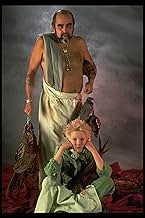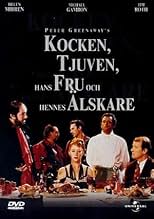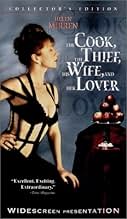Le Cuisinier, le voleur, sa femme et son amant
Titre original : The Cook, the Thief, His Wife & Her Lover
La femme d'un violent criminel, propriétaire d'un restaurant, se console dans les bras d'un aimable client, habitué des lieux.La femme d'un violent criminel, propriétaire d'un restaurant, se console dans les bras d'un aimable client, habitué des lieux.La femme d'un violent criminel, propriétaire d'un restaurant, se console dans les bras d'un aimable client, habitué des lieux.
- Récompenses
- 7 victoires et 11 nominations au total
Ciarán Hinds
- Cory
- (as Ciaran Hinds)
Roger Ashton-Griffiths
- Turpin
- (as Roger Ashton Griffiths)
Histoire
Le saviez-vous
- AnecdotesThe four title characters were named for the actors and actress writer and director Peter Greenaway originally wanted to play them. Richard (The Cook) was for Richard Bohringer, the only one of Greenaway's original choices retained in the final movie. Albert (The Thief) was named after Albert Finney, while Georgina (His Wife) was for Georgina Hale. Michael (The Lover) was named, interestingly enough, for Sir Michael Gambon, who Greenaway eventually re-cast as Albert.
- GaffesWhen Albert (Michael Gambon) goes into the ladies' toilet and starts throwing women out of the cubicles, the second one has, as you would expect, her underwear around her knees. But her skirt rides right up, revealing that she is still wearing her underwear, and that the ones below are a prop.
- Crédits fousClosing credits epilogue: "And a special thanks to those very many people who patiently & repeatedly performed as patients & nurses in the hospital ward, and as diners in the Hollandais Restaurant."
- Versions alternativesAn edited, R-rated version is available on video.
Commentaire à la une
With the Cook, the Thief, his Wife and her Lover, Greenaway creates a self-contained world that is both a fabrication and abstraction of reality, but also an extremist reflection (nee, microcosm) of British society in the nineteen-eighties. The characters that he chooses to put forward to the audience as protagonists are archetypes of social and political caricatures that we would find in that particular decade; but heightened to conform to the over-the-top opulence/pestilence found central to the plot. His ability to craft characters and situations that resonate beyond the context of a particular scenario, coupled with his bitterness and unwillingness to conform is what sets him up as a satirist of serious note. He also elevates the film beyond the realms of mere art-house experimentation by fashioning a seriously funny script, which has ample opportunities for central character Albert Spica to prove himself the ultimate charismatic bully - part cockney hard man, part pantomime villain - who is never less than compulsively terrifying.
The plot is a simple construct centred on the theme of revenge and the need for personal freedom. This is mixed in with the socio-political undertones as well as Greenaway's many references to art, theatre, film and literature. It is also elevated by the impeccable cinematic qualities that we hold synonymous with the director's work. Everything here is about pushing things beyond the reasonable limitations; so we have a stunningly intricate set that is both theatrically simplistic, but also as other-worldly as anything from the work of say Gilliam or Jeunet. The costumes by Jean Paul Gaultier scream over-the-top chic, whilst often mirroring the use of colour employed by the production designers. Greenaway even breaks continuity by having Helen Mirren's costumes change colour as she moves through each room of the restaurant, so that we have a green dress in the kitchen, a red dress in the dinning area (inspired by Hitchcock's vertigo no less) and a white dress in the lavatory. It's an audacious move, but one that pays off in the creation of a completely self-contained world; something that is further established by Sacha Vierny's sumptuous cinematography and the wonderfully bombastic music of the ever-excellent Michael Nyman.
Some have clearly found the film's various abstractions problematic (yes, it is theatrical, yes it is occasionally shocking, and yes, it does evolve in a world of its own ostentatious creation). But it's also as artistic a film as you can get; a fact that some here have disputed. The reason that some define this as artistic refers to the use of colour, light and composition. The architecture of the sets too, and the way in which the production designers have chosen to dress them also adds to the artistic stylisation of the film. These factors are important to the narrative, as they are symbolic to what Greenaway is trying to convey, as well as what the characters are all about. Because of this, the design of the film becomes AS important as the framework, if not more so. But this film is more than a mere arty exploration; it's funny and intelligent and features a slew of great performances from a wonderfully eclectic cast. Michael Gambon as the thief Spica gives a grandstand performance to rival his own Phillip Marlow from The Singing Detective; hamming things up spectacularly but still retaining that much needed sense of humanity. The same can be said of the other principals too.
Mirren as the wife exudes a quite and restrained sexuality in what must be her best performance, whist Richard Bohringer as the cook is in some represents the linchpin/catalyst for the film. Elsewhere we find everyone from Tim Roth to Ian Dury popping up to give the film some added character and easily furthering the film's already cult appeal. This was a turning point for Greenaway; a move towards the more expressive, elaborate and self-contained style of film-making found in films like Prospero's Books and the Baby of Maçon and away from the more easy to digest classics like the Draughtsman's Contract, Drowning by Numbers and A Zed and Two Noughts.
The plot is a simple construct centred on the theme of revenge and the need for personal freedom. This is mixed in with the socio-political undertones as well as Greenaway's many references to art, theatre, film and literature. It is also elevated by the impeccable cinematic qualities that we hold synonymous with the director's work. Everything here is about pushing things beyond the reasonable limitations; so we have a stunningly intricate set that is both theatrically simplistic, but also as other-worldly as anything from the work of say Gilliam or Jeunet. The costumes by Jean Paul Gaultier scream over-the-top chic, whilst often mirroring the use of colour employed by the production designers. Greenaway even breaks continuity by having Helen Mirren's costumes change colour as she moves through each room of the restaurant, so that we have a green dress in the kitchen, a red dress in the dinning area (inspired by Hitchcock's vertigo no less) and a white dress in the lavatory. It's an audacious move, but one that pays off in the creation of a completely self-contained world; something that is further established by Sacha Vierny's sumptuous cinematography and the wonderfully bombastic music of the ever-excellent Michael Nyman.
Some have clearly found the film's various abstractions problematic (yes, it is theatrical, yes it is occasionally shocking, and yes, it does evolve in a world of its own ostentatious creation). But it's also as artistic a film as you can get; a fact that some here have disputed. The reason that some define this as artistic refers to the use of colour, light and composition. The architecture of the sets too, and the way in which the production designers have chosen to dress them also adds to the artistic stylisation of the film. These factors are important to the narrative, as they are symbolic to what Greenaway is trying to convey, as well as what the characters are all about. Because of this, the design of the film becomes AS important as the framework, if not more so. But this film is more than a mere arty exploration; it's funny and intelligent and features a slew of great performances from a wonderfully eclectic cast. Michael Gambon as the thief Spica gives a grandstand performance to rival his own Phillip Marlow from The Singing Detective; hamming things up spectacularly but still retaining that much needed sense of humanity. The same can be said of the other principals too.
Mirren as the wife exudes a quite and restrained sexuality in what must be her best performance, whist Richard Bohringer as the cook is in some represents the linchpin/catalyst for the film. Elsewhere we find everyone from Tim Roth to Ian Dury popping up to give the film some added character and easily furthering the film's already cult appeal. This was a turning point for Greenaway; a move towards the more expressive, elaborate and self-contained style of film-making found in films like Prospero's Books and the Baby of Maçon and away from the more easy to digest classics like the Draughtsman's Contract, Drowning by Numbers and A Zed and Two Noughts.
- ThreeSadTigers
- 27 mars 2008
- Permalien
Meilleurs choix
Connectez-vous pour évaluer et suivre la liste de favoris afin de recevoir des recommandations personnalisées
Détails
- Date de sortie
- Pays d’origine
- Site officiel
- Langues
- Aussi connu sous le nom de
- El cocinero, el ladrón, su esposa y su amante
- Lieux de tournage
- Sociétés de production
- Voir plus de crédits d'entreprise sur IMDbPro
Box-office
- Montant brut aux États-Unis et au Canada
- 7 724 701 $US
- Week-end de sortie aux États-Unis et au Canada
- 252 223 $US
- 8 avr. 1990
- Montant brut mondial
- 8 526 030 $US
- Durée2 heures 4 minutes
- Couleur
- Rapport de forme
- 2.35 : 1
Contribuer à cette page
Suggérer une modification ou ajouter du contenu manquant

Lacune principale
What is the streaming release date of Le Cuisinier, le voleur, sa femme et son amant (1989) in Brazil?
Répondre



































